| Chairman of the Joint Chiefs of Staff | |
|---|---|
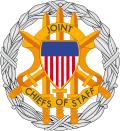 Seal of the Joint Chiefs of Staff Seal of the Joint Chiefs of Staff | |
 Flag of the chairman of the Joint Chiefs of Staff Flag of the chairman of the Joint Chiefs of Staff | |
 Incumbent IncumbentGeneral Charles Q. Brown Jr., USAF since 1 October 2023 | |
| Joint Chiefs of Staff Department of Defense | |
| Type | Highest-ranking military officer |
| Abbreviation | CJCS |
| Member of | Joint Chiefs of Staff National Security Council |
| Reports to | President Secretary of Defense |
| Residence | Quarters 6, Fort Myer |
| Seat | The Pentagon, Arlington County, Virginia |
| Nominator | Secretary of Defense |
| Appointer | The President with Senate advice and consent |
| Term length | 4 years, not renewable |
| Constituting instrument | 10 U.S.C. § 152 10 U.S.C. § 153 |
| Precursor | Chief of Staff to the Commander in Chief of the Army and Navy |
| Formation | 19 August 1949 |
| First holder | General of the Army Omar Bradley |
| Deputy | Vice Chairman Director (Joint Staff) Senior Enlisted Advisor (Enlisted Matters) |
| Website | www |
The chairman of the Joint Chiefs of Staff (CJCS) is the presiding officer of the Joint Chiefs of Staff (JCS). The chairman is the highest-ranking and most senior military officer in the United States Armed Forces and the principal military advisor to the president, the National Security Council, the Homeland Security Council, and the secretary of defense. While the chairman of the Joint Chiefs of Staff outranks all other commissioned officers, the chairman is prohibited by law from having operational command authority over the armed forces; however, the chairman assists the president and the secretary of defense in exercising their command functions.
The chairman convenes the meetings and coordinates the efforts of the Joint Chiefs, an advisory body within the Department of Defense comprising the chairman, the vice chairman of the Joint Chiefs of Staff, the chief of staff of the Army, the commandant of the Marine Corps, the chief of naval operations, the chief of staff of the Air Force, the chief of space operations, and the chief of the National Guard Bureau. The post of a statutory and permanent Joint Chiefs of Staff chair was created by the 1949 amendments to the National Security Act of 1947. The 1986 Goldwater–Nichols Act elevated the chairman from the first among equals to becoming the "principal military advisor" to the president and the secretary of defense.
The Joint Staff, managed by the director of the Joint Staff and consisting of military personnel from all the services, assists the chairman in fulfilling his duties to the president and secretary of defense, and functions as a conduit and collector of information between the chairman and the combatant commanders. The National Military Command Center (NMCC) is part of the Joint Staff operations directorate (J-3).
Although the office of Chairman of the Joint Chiefs of Staff is considered very important and highly prestigious, neither the chairman, the vice chairman, nor the Joint Chiefs of Staff as a body has any command authority over combatant forces. The Goldwater–Nichols Act places the operational chain of command from the president to the secretary of defense directly to the commanders of the unified combatant commands. However the service chiefs do have authority over personnel assignments and oversight over resources and personnel allocated to the combatant commands within their respective services (derived from the service secretaries).
The chairman may also transmit communications to the combatant commanders from the president and secretary of defense as well as allocate additional funding to the combatant commanders if necessary. The chairman also performs all other functions prescribed under 10 U.S.C. § 153 or allocates those duties and responsibilities to other officers in the joint staff.
The current chairman is General Charles Q. Brown Jr., who assumed office on 1 October 2023, having been ceremonially sworn in on 29 September.
Organization and assistants
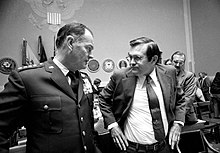
The principal deputy to the chairman is the vice chairman of the Joint Chiefs of Staff (VCJCS), another four-star general or admiral, who among many duties chairs the Joint Requirements Oversight Council (JROC).
The chairman of the Joint Chiefs of Staff is assisted by the Joint Staff, led by the director of the Joint Staff, a three-star general or admiral. The Joint Staff is an organization composed of approximately equal numbers of officers contributed by the Army, Navy, Marine Corps, Air Force, and Space Force who have been assigned to assist the chairman with the unified strategic direction, operation, and integration of the combatant land, naval, air, and space forces. The National Military Command Center (NMCC) is part of the Joint Staff operations directorate (J-3).
The chairman of the Joint Chiefs of Staff is also advised on enlisted personnel matters by the senior enlisted advisor to the chairman, who serves as a communication conduit between the chairman and the senior enlisted advisors (command sergeants major, command master chief petty officers, and command chief master sergeants) of the combatant commands.
Precursor
Fleet Admiral William D. Leahy, USN, served as the chief of staff to the commander in chief of the Army and Navy from 20 July 1942 to 21 March 1949. He presided over meetings of what was called the Joint Chiefs of Staff, and Leahy's office was the precursor to the post of Chairman of the Joint Chiefs of Staff.
Appointment and rank


The chairman is nominated by the president for appointment from any of the regular components of the armed forces, and must be confirmed via majority vote by the Senate. The chairman and vice chairman may not be members of the same armed force service branch. However, the president may waive that restriction for a limited period of time in order to provide for the orderly transition of officers appointed to serve in those positions. The chairman serves a single four-year term of office at the pleasure of the president, with reappointment to additional terms only possible during times of war or national emergency.
Historically, the chairman served two two-year terms, until the National Defense Authorization Act for Fiscal Year 2017 amended the chairman's term of office to a single four-year term. By statute, the chairman is appointed as a four-star general or admiral while holding office and assumes office on 1 October of odd-numbered years.
Although the first chairman of the Joint Chiefs of Staff, Omar Bradley, was eventually awarded a fifth star, the CJCS does not receive one by right, and Bradley's award was so that his subordinate, General of the Army Douglas MacArthur, would not outrank him. In the 1990s, there were proposals in Department of Defense academic circles to bestow on the chairman a five-star rank.
Previously during the presidency of Harry S. Truman and Dwight D. Eisenhower, the chairman of the Joint Chiefs of Staff position was rotated in accordance with the incumbent chairman's armed force service branch. In this rotation, the incoming chairman would be from a different service branch. For example, in 1957, following the retirement of Admiral Arthur Radford as Chairman of the Joint Chiefs of Staff, President Eisenhower nominated Air Force general Nathan Twining as Radford's successor. When General Twining retired, Eisenhower nominated Army general Lyman Lemnitzer to succeed Twining as chairman.
In October 1962, when President Kennedy appointed Army general Maxwell Taylor as General Lemnitzer's successor, Kennedy eventually broke the traditional rotation for the position between the Air Force, Navy, Marines, and Army. Kennedy replaced a chairman who was from the Army with another general who was also from the Army. At that time, Kennedy should have appointed either Air Force chief of staff General Curtis LeMay, chief of naval operations Admiral George Anderson Jr., or commandant of the Marine Corps General David Shoup to succeed General Lemnitzer as the fifth chairman of the Joint Chiefs of Staff. Since that, the traditional rotation was abolished.
According to the Monthly Rates of Basic Pay for commissioned officers, effective January 1, 2023, basic pay is limited to the rate of basic pay for level II of the Executive Schedule in effect during calendar year 2023, which is $17,675.10 per month for officers at pay grades O-7 through O-10. This includes officers serving as chairman or vice chairman of the Joint Chiefs of Staff, chief of staff of the Army, chief of naval operations, chief of staff of the Air Force, commandant of the Marine Corps, chief of space operations, commandant of the Coast Guard, chief of the National Guard Bureau, or the commanders of the unified combatant commands.
List of chairmen
Chief of Staff to the Commander in Chief (historical predecessor office)
| Image | Name | Start | End | Duration | Service Branch | President(s) | |
|---|---|---|---|---|---|---|---|
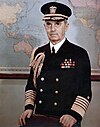
|
William D. Leahy | 20 July 1942 | 21 March 1949 | 6 years, 244 days |  U.S. Navy |
Franklin D. Roosevelt (1933–1945) | |
| Harry S. Truman (1945–1953) | |||||||
Chairmen of the Joint Chiefs of Staff
| Image | Name | Start | End | Duration | Service Branch | President(s) | |
|---|---|---|---|---|---|---|---|

|
Omar Bradley | 19 August 1949 | 15 August 1953 | 3 years, 361 days |  U.S. Army |
Harry S. Truman (1945–1953) | |
| Dwight D. Eisenhower (1953–1961) | |||||||

|
Arthur W. Radford | 15 August 1953 | 15 August 1957 | 4 years, 0 days |  U.S. Navy | ||

|
Nathan F. Twining | 15 August 1957 | 30 September 1960 | 3 years, 46 days |  U.S. Air Force | ||

|
Lyman Lemnitzer | 1 October 1960 | 30 September 1962 | 2 years, 0 days |  U.S. Army | ||
| John F. Kennedy (1961–1963) | |||||||
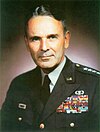
|
Maxwell D. Taylor | 1 October 1962 | 1 July 1964 | 1 year, 275 days |  U.S. Army | ||
| Lyndon B. Johnson (1963–1969) | |||||||
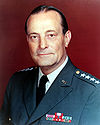
|
Earle Wheeler | 3 July 1964 | 2 July 1970 | 5 years, 364 days |  U.S. Army | ||
| Richard Nixon (1969–1974) | |||||||

|
Thomas Moorer | 2 July 1970 | 1 July 1974 | 3 years, 364 days |  U.S. Navy | ||

|
George S. Brown | 1 July 1974 | 20 June 1978 | 3 years, 354 days |  U.S. Air Force | ||
| Gerald Ford (1974–1977) | |||||||
| Jimmy Carter (1977–1981) | |||||||

|
David C. Jones | 21 June 1978 | 18 June 1982 | 3 years, 362 days |  U.S. Air Force | ||
| Ronald Reagan (1981–1989) | |||||||
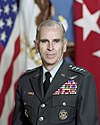
|
John Vessey | 18 June 1982 | 30 September 1985 | 3 years, 104 days |  U.S. Army | ||

|
William Crowe | 1 October 1985 | 30 September 1989 | 3 years, 364 days |  U.S. Navy | ||
| George H. W. Bush (1989–1993) | |||||||
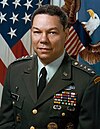
|
Colin Powell | 1 October 1989 | 30 September 1993 | 3 years, 364 days |  U.S. Army | ||
| Bill Clinton (1993–2001) | |||||||
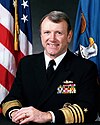
|
David E. Jeremiah Acting |
1 October 1993 | 24 October 1993 | 23 days |  U.S. Navy | ||

|
John Shalikashvili | 25 October 1993 | 30 September 1997 | 3 years, 341 days |  U.S. Army | ||

|
Hugh Shelton | 1 October 1997 | 30 September 2001 | 3 years, 364 days |  U.S. Army | ||
| George W. Bush (2001–2009) | |||||||

|
Richard Myers | 1 October 2001 | 30 September 2005 | 3 years, 364 days |  U.S. Air Force | ||

|
Peter Pace | 1 October 2005 | 30 September 2007 | 1 year, 364 days |  U.S. Marine Corps | ||

|
Michael Mullen | 1 October 2007 | 30 September 2011 | 3 years, 364 days |  U.S. Navy | ||
| Barack Obama (2009–2017) | |||||||

|
Martin Dempsey | 1 October 2011 | 30 September 2015 | 3 years, 364 days |  U.S. Army | ||

|
Joseph Dunford | 1 October 2015 | 30 September 2019 | 3 years, 364 days |  U.S. Marine Corps | ||
| Donald Trump (2017–2021) | |||||||

|
Mark Milley | 1 October 2019 | 30 September 2023 | 3 years, 364 days |  U.S. Army | ||
| Joe Biden (2021–2025) | |||||||
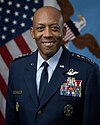
|
Charles Q. Brown Jr. | 1 October 2023 | Incumbent | 1 year, 94 days |  U.S. Air Force | ||
| Donald Trump (2025) | |||||||
Chairmen of the Joint Chiefs of Staff by branches of service within the Department of Defense
- Army: 10
- Air Force: 5
- Navy: 4
- Marine Corps: 2
- Space Force: 0
Timeline

See also
- Chief of Defence
- National Command Authority (United States)
- National Military Strategy (United States)
- Single Integrated Operational Plan
- Unified Command Plan
References
Citations
- "Quarters Six, The Official Residence of the Chairman of the Joint Chiefs of Staff" (PDF). Retrieved 17 May 2021.
- ^ 10 U.S.C. § 152 Chairman: appointment; grade and rank
- ^ 10 U.S.C. § 151 - Joint Chiefs of Staff: composition; functions
- "Joint Chiefs of Staff Official Web Site". Archived from the original on 14 May 2011. Retrieved 24 September 2009. Goldwater–Nichols Act of 1986
- 10 U.S.C. § 153 - Chairman: functions
- 10 U.S.C. § 162 - Combatant commands: assigned forces; chain of command
- 10 U.S.C. § 163 - Role of Chairman of Joint Chiefs of Staff
- 10 U.S.C. § 166a - Combatant commands: funding through the Chairman of Joint Chiefs of Staff
- "Webcast: Armed Forces Farewell Tribute in Honor of General Mark A. Milley and an Armed Forces Hail in Honor of General Charles Q. Brown Jr". DVIDS. Retrieved 29 September 2023.
- "Washington Eats". Life. 5 October 1942. p. 95. Retrieved 20 November 2011.
- ^ 10 U.S.C. § 154 - Vice Chairman
- ^ Public Law 114–328 - The National Defense Authorization Act for Fiscal Year 2017 increased the term length Chairman and the Vice Chairman of the Joint Chiefs of Staff from two years to four years.
- Abrams, Jim (22 March 1991). "Higher rank not in the stars for nation's top generals". Associated Press.
Bradley received his fifth star in 1950 when he became chairman of the Joint Chiefs of Staff so he would not be outranked by MacArthur.
- Tillman, Barrett (2004). Brassey's D-Day encyclopedia: the Normandy invasion A-Z. Brassey's. p. 48. ISBN 978-1-57488-760-0. Retrieved 22 February 2011.
MacArthur, having been army chief of staff before World War II, was senior to everyone on the Joint Chiefs, and some observers felt that Bradley was given his fifth star in order to deal with the vainglorious field commander on an equal footing.
- Organizing for National Security: The Role of the Joint Chiefs of Staff. Institute for Foreign Analysis. January 1986. p. 11. ISBN 9780895490742. Retrieved 21 February 2011.
There was some discussion of the proposal to grant the Chairman of the Joint Chiefs five-star rank, as a symbol of his status as the most senior officer in the armed forces.
- Jones, Logan (February 2000). Toward the Valued Idea of Jointness: The Need for Unity of Command in U.S. Armed Forces (PDF). Defense Technical Information Center (Report). Naval War College. p. 2. ADA378445. Archived from the original on 1 June 2022. Retrieved 21 February 2011.
Promoting the Chairman to the five-star rank and ceding to him operational and administrative control of all U.S. Armed Forces would enable him to provide a unifying vision...
- Owsley, Robert Clark (June 1997). Goldwater-Nichols Almost Got It Right: A Fifth Star for the Chairman (PDF) (Report). Naval War College. p. 14. ADA328220. Archived from the original on 17 September 2021. Retrieved 21 February 2011.
...Chairman's title be changed to Commander of the Armed Forces and commensurate with the title and authority he be assigned the grade of five stars.
- ^ Rearden, Steven L. (30 July 2012). Council of War: A History of the Joint Chiefs of Staff, 1942-1991. Military Bookshop. ISBN 978-1780398877.
- McMaster, Herbert Raymond (8 May 1998). Dereliction of Duty: Johnson, McNamara, the Joint Chiefs of Staff, and the Lies That Led to Vietnam. Harper Perennial. p. 22. ISBN 978-0060929084.
- Perry, Mark (1 March 1989). Four-Stars: The Inside Story of The Forty-Year Battle Between The Joint Chiefs of Staff and America's Civilian Leaders. Houghton Mifflin. ISBN 978-0395429235.
- ^ "Defense Finance and Accounting Service > MilitaryMembers > payentitlements > Pay Tables > Basic Pay > CO". www.dfas.mil. Retrieved 8 August 2023.
- Excluding Leahy, who served in a precursor position, and Jeremiah, who served as acting Chairman.
General sources
- Department of Defense Directive 5100.1: Functions of the Department of Defense and Its Major Components (PDF). Department of Defense Directive. Washington, D.C.: U.S. Department of Defense. 21 December 2010. Archived from the original (PDF) on 22 March 2011.
- "Department of Defense Directive 5100.01 Functions of the Department of Defense and Its Major Components". Office of the Secretary Defense, Director of Administration and Management, Directorate for Organizational & Management Planning. Archived from the original on 7 May 2013. Retrieved 13 June 2013.


